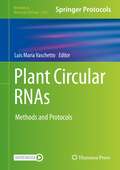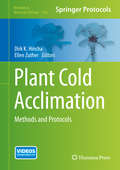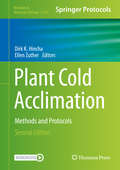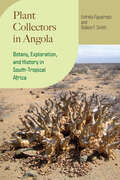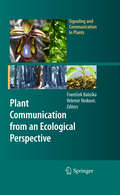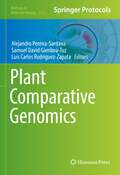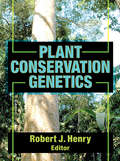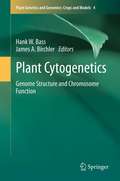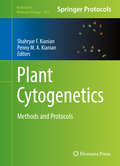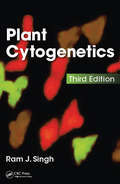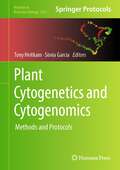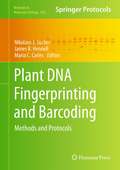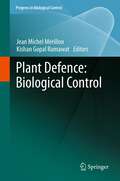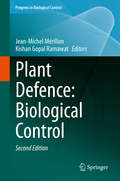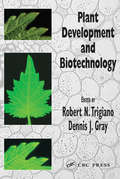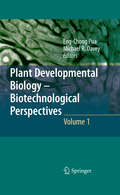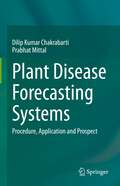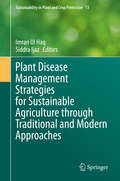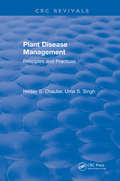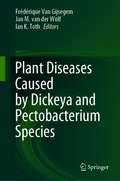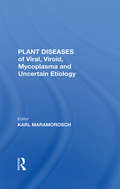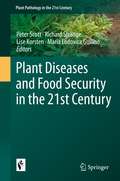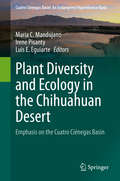- Table View
- List View
Plant Circular RNAs: Methods and Protocols (Methods in Molecular Biology #2362)
by Luis María VaschettoThis volume presents readers with up-to-date protocols, bioinformatics toolkits, and reference material for understanding circRNAs in plants. The chapters in this book summarize the concepts and techniques for prediction/identification, validation, and analysis of plant circRNAs and their regulatory targets. Some of the topics covered are procedures for circRNA identification and characterization; strategies for circRNA generation; next generation sequencing (NGS) technologies and circRNAs’ research; and bioinformatics tools and pipelines for the analysis of circRNA-miRNA-mRNA regulatory networks. Written in the highly successful Methods in Molecular Biology series format, chapters include introductions to their respective topics, lists of the necessary materials and reagents, step-by-step, readily reproducible laboratory protocols, and tips on troubleshooting and avoiding known pitfalls. Authoritative and practical, Plant Circular RNAs: Methods and Protocols is an important reference for any researcher looking to explore and apply the latest developments made in this field.
Plant Cold Acclimation
by Dirk K. Hincha Ellen ZutherPlant Cold Acclimation: Methods and Protocols details many of the methods and protocols commonly used to study plant cold acclimation and freezing tolerance, breeding, genetics, physiology or molecular biology, or any combination of these specialties. Chapters focus on interdisciplinary approaches, experimental methods, and concepts from different areas of science. Written in the highly successful Methods in Molecular Biology series format, chapters include introductions to their respective topics, lists of the necessary materials and reagents, step-by-step, readily reproducible laboratory protocols, and key tips on troubleshooting and avoiding known pitfalls. Authoritative and practical, Plant Cold Acclimation: Methods and Protocols seeks to help not only new researchers starting in this field, but also those already working in a particular area of cold acclimation and freezing tolerance research who are looking to expand their range of experimental approaches.
Plant Cold Acclimation: Methods and Protocols (Methods in Molecular Biology #2156)
by Dirk K. Hincha Ellen ZutherThis detailed new edition combines a wide selection of experimental methods for plant cold acclimation, deacclimation, and cold memory, ranging from the whole plant level of ecology and breeding to molecular profiling and the detailed analysis of specific proteins, with many levels of investigated complexity in between. The collection updates methodology from the first edition while adding chapters on numerous key advances in the field. Written for the highly successful Method in Molecular Biology series, chapters include introductions to their respective topics, lists of the necessary materials and reagents, step-by-step, readily reproducible laboratory protocols, and tips on troubleshooting and avoiding known pitfalls. Authoritative and up-to-date, Plant Cold Acclimation: Methods and Protocols, Second Edition seeks to aid researchers, both new and experienced, in entering this exciting field of research or broadening the scope of their investigations.
Plant Collectors in Angola: Botany, Exploration, and History in South-Tropical Africa (Regnum Vegetabile)
by Estrela Figueiredo Gideon F. SmithAn authoritative treatise on the history of botanical studies and exploration in Angola. For any region, cataloging, interpreting, and understanding the history of botanical exploration and plant collecting, and the preserved specimens that were amassed as a result, are critically important for research and conservation. In this book, published in cooperation with the International Association for Plant Taxonomy, Estrela Figueiredo and Gideon F. Smith, both botanists with expertise in the taxonomy of African plants, provide the first comprehensive, contextualized account of plant collecting in Angola, a large country in south-tropical Africa. An essential book for anyone concerned with the biodiversity and history of Africa, this authoritative work offers insights into the lives, times, and endeavors of 358 collectors. In addition, the authors present analyses of the records that accompanied the collectors’ preserved specimens. Illustrated in color throughout, the book fills a large gap in the current knowledge of the botanical and exploration history of Africa.
Plant Communication from an Ecological Perspective
by František Baluška Velemir NinkovicThis book shows the complexity of plant signaling and behavior in an ecological context and is intended to increase our understanding of it. It reflects the multifaceted interactions between plants and other organisms that affect their growth and development. In addition it puts emphasis on the effects of plant signaling and behavior on other trophic levels. This field of research is growing and developing rapidly, and new findings are regularly reported. Thus, this book provides a broader view of the field and represents a valuable reference work on the current state of research.
Plant Comparative Genomics (Methods in Molecular Biology #2512)
by Alejandro Pereira-Santana Samuel David Gamboa-Tuz Luis Carlos Rodríguez-ZapataThis detailed book presents recent methodologies for the task of inspecting the genomic world of plants, extracting valuable information, and presenting it in a readable way. With a focus on bioinformatics tools, the volume explores phylogenetics and evolution, Omics analysis, as well as experimental procedures for trait characterization. Written for the highly successful Methods in Molecular Biology series, chapters include the kind of vital expert implementation advice that will lead to successful results. Authoritative and practical, Plant Comparative Genomics serves as an ideal resource for researchers looking to implement comparative tools in order to explore their genomic data for their daily scientific work.
Plant Conservation Genetics
by Robert J. HenryA practical guide that covers both in situ and ex situ techniques for plant diversity conservationThe conservation and sustainable use of plant genetic resources is of increasing importance globally. Plant Conservation Genetics addresses this issue by providing an extensive overview of this emerging area of science, exploring various pr
Plant Cytogenetics
by James A. Birchler Hank BassThis reference book provides information on plant cytogenetics for students, instructors, and researchers. Topics covered by international experts include classical cytogenetics of plant genomes; plant chromosome structure; functional, molecular cytology; and genome dynamics. In addition, chapters are included on several methods in plant cytogenetics, informatics, and even laboratory exercises for aspiring or practiced instructors. The book provides a unique combination of historical and modern subject matter, revealing the central role of plant cytogenetics in plant genetics and genomics as currently practiced. This breadth of coverage, together with the inclusion of methods and instruction, is intended to convey a deep and useful appreciation for plant cytogenetics. We hope it will inform and inspire students, researchers, and teachers to continue to employ plant cytogenetics to address fundamental questions about the cytology of plant chromosomes and genomes for years to come. Hank W. Bass is a Professor in the Department of Biological Science at Florida State University. James A. Birchler is a Professor in the Division of Biological Sciences at the University of Missouri.
Plant Cytogenetics
by Shahryar F. Kianian Penny M. A. KianianThis volume covers arange of methods used in plant cytogenetics, beginning with basic analysis ofchromosomes and visualizing gene locations, to manipulating and dissectingchromosomes, and then focusing on less understood features of chromosomes suchas recombination initiation sites and epigenomic marks. The methods describedin Plant Cytogenetics: Methods and Protocols build on each other andprovide, those new to the field, with a comprehensive platform to support theirresearch endeavours, while also introducing advanced techniques to experiencedresearchers. Written in the highly successful Methods in Molecular Biology seriesformat, chapters include introductions to their respective topics, lists of thenecessary materials and reagents, step-by-step, readily reproducible laboratoryprotocols, and tips on troubleshooting and avoiding known pitfalls. Cuttingedge and thorough, Plant Cytogenetics: Methods and Protocols, is avaluable resource for anyone who is interested in the diverse and wonderfullycomplex field of cytogenetics.
Plant Cytogenetics
by Ram J. SinghCytogenetics plays an important role in understanding the chromosomal and genetic architecture of plant species. Plant Cytogenetics, Third Edition follows the tradition of its predecessors presenting theoretical and practical aspects of plant cytogenetics. Chapters describe correct handling of plant chromosomes, methods in plant cytogenetics, cell division, reproduction methods, chromosome nomenclature, karyotype analysis, chromosomal aberrations, genome analysis, transgenic crops, and cytogenetics in plant breeding. This new edition begins with a brief introduction on the historical aspect of cytogenetics and flows directly into handling of plant chromosomes by classical and modern cytological techniques, classical Mendelian Genetics, brief description of cell division, and chromosome identification by karyotype analysis. The comprehension of cytogenetics is incomplete without information on the role of aneuploidy in associating a gene on a particular chromosome, and the book covers these methodologies as a primary topic. Covering classical to modern cytogenetics, the book presents to the reader the crucial role of cytogenetics in improving crops.
Plant Cytogenetics and Cytogenomics: Methods and Protocols (Methods in Molecular Biology #2672)
by Tony Heitkam Sònia GarciaThis book provides an up-to-date account of the most widespread methods used by specialists in the field of plant cytogenetics and the emerging field of cytogenomics that will likely soon be adapted by more labs. From the classical basic karyological approaches to the most recent genomics-informed and computational methods, the volume explores genome size and ploidy level estimation, chromosome fixation, preparation, and manipulation, banding and staining techniques, in situ hybridization, as well as numerous methods that integrate cytogenetics with bioinformatics and computational genomics. Written for the highly successful Methods in Molecular Biology series, chapters include introductions to their respective topics, lists of the necessary materials and reagents, step-by-step and readily reproducible laboratory protocols, as well as tips on troubleshooting and avoiding known pitfalls. Authoritative and practical, Plant Cytogenetics and Cytogenomics: Methods and Protocols serves as an ideal resource for plant scientists interested in molecular and evolutionary biology, breeding, systematics, and plant -omics in general.
Plant DNA Fingerprinting and Barcoding
by Maria C. Carles James R. Hennell Nikolaus J. SucherMolecular cloning and DNA-based analysis have become part of every molecular life science laboratory. The rapid adoption of DNA-based techniques has been facilitated by the introduction of the polymerase chain reaction (PCR), which has made cloning and characterization of DNA quick and relatively simple. PCR is virtually part of every variation of the plethora of approaches used for DNA fingerprinting today. Plant DNA Fingerprinting: Methods and Protocols aims to bring together the different currently available genome-based techniques into one repository. This volume contains detailed protocols for the preparation of plant genomic DNA, fingerprinting of plants for the detection of intra-species variations, the use of DNA barcoding, as well as methods for the bioinformatic analysis of data. Also included are several discussions on the broader issues of genome-based approaches in order to provide a sound understanding of the principles of these methods. Written in the successful Methods in Molecular BiologyTM series format, chapters include introductions to their respective topics, lists of the necessary materials and reagents, step-by-step, readily reproducible protocols, and notes on troubleshooting and avoiding known pitfalls. Authoritative and easily accessible, Plant DNA Fingerprinting: Methods and Protocols is tailored principally for those who seek to augment their current methods of plant analysis and quality control using genome-based approaches as well as for scientists and researchers in different plant sciences.
Plant Defence: Biological Control
by Kishan Gopal Ramawat Jean Michel MérillonTo meet the challenge of feeding ever increasing human population, efficient, economical and environment friendly disease control methods are required. Pests are responsible for heavy crop losses and reduced food supplies, poorer quality of agricultural products, economic hardship for growers and processor. Generally, chemical control methods are neither always economical nor are they effective and may have associated unwanted health, safety and environmental risks. Biological control involves use of beneficial microorganism to control plant pathogens and diseases they cause and offers an environmental friendly approach to the effective management of plant diseases. This book provides a comprehensive account of interaction of host and its pathogens, induced host resistance, development of biological control agents for practical applications, the underlying mechanism and signal transduction. The book is useful to all those working in academia or industry related to crop protection.
Plant Defence: Biological Control (Progress in Biological Control #22)
by Kishan Gopal Ramawat Jean-Michel MérillonInsects, pests and weeds are responsible for substantial loss of crops and reduced food supplies, poorer quality of agricultural products, economic hardship for growers and processor. Generally, chemical control methods are neither always economical nor are they effective and may have associated unwanted health, safety and environmental risks. Biological control involves use of beneficial biological agents to control pests and offers an environmental friendly approach to the effective management of plant diseases and weeds. The chapters are written by well recognized group leaders in the field. This book provides a comprehensive account of interaction of host and pests, and development of biological control agents for practical applications in crops management utilizing inherent defence mechanism, induced stimulation and biological control agents. The contents are divided into the following sections: General biology of plant defence, Use of natural compounds for biological control, Use of biological agents, Mechanism of action and Commercial aspects. The book will be useful for academicians, researcher and industries involved in study and manufacturing these products.
Plant Desiccation Tolerance
by Erwin Beck Ulrich Lüttge Dorothea BartelsDesiccation tolerance was essential when plants first began to conquer land, roughly 400 million years ago. While most desiccation-tolerant plants belong to basal phylogenetic taxa, this capacity has also evolved among some vascular plant species. In this volume renowned experts treat plant desiccation tolerance at the organismic as well as at the cellular level. The diversity of ecophysiological adaptations and acclimations of cyanobacteria, eukaryotic algae, mosses, and lichens is addressed in several chapters. The particular problems of vascular plants during dehydration/rehydration cycles resulting not only from their hydraulic architectures, but also from severe secondary stresses associated with the desiccated state are discussed. Based on the treatment of desiccation tolerance at the organismic level, a second section of the book is devoted to the cell biological level. It delineates the general concepts of functional genomics, epigenetics, genetics, molecular biology and the sensing and signalling networks of systems biology involved in dehydration/rehydration cycles. This book provides an invaluable compilation of current knowledge, which is a prerequisite for a better understanding of plant desiccation tolerance in natural as well as agro- and forest ecosystems where water is one of the most essential resources.
Plant Development and Biotechnology
by Robert N. Trigiano Dennis J. GrayBiotechnology revolutionized traditional plant breeding programs. This rapid change produced new discussions on techniques and opportunities for commerce, as well as a fear of the unknown. Plant Development and Biotechnology addresses the major issues of the field, with chapters on broad topics written by specialists. The book applies an informal s
Plant Developmental Biology
by Lars Hennig Claudia KöhlerThe beauty and variety of plants has fascinated mankind for thousands of years, and this fascination continues today as plant developmental biologists discover mechanisms that control the establishment of specialized cell types, tissues, and organs from the fertilized egg during a plant's life. In Plant Developmental Biology: Methods and Protocols, expert researchers provide a collection of protocols for many of the common experimental approaches in plant developmental biology, including diverse methods that range from grafting over bimolecular fluorescence complementation to chromatin immunoprecipitation. Chapters are divided into six major parts: growth protocols, manipulation of gene activity, assaying developmental phenotypes, assaying gene activity, testing protein-protein interactions, and probing chromatin. Composed in the highly successful Methods in Molecular BiologyTM series format, each chapter contains a brief introduction, step-by-step methods, a list of necessary materials, and a Notes section which shares tips on troubleshooting and avoiding known pitfalls. Comprehensive and revolutionary, Plant Developmental Biology: Methods and Protocols is an essential guide for all plant developmental geneticists, biochemists, and researchers in stress physiology and plant nutrition.
Plant Developmental Biology - Biotechnological Perspectives
by Michael R. Davey Eng Chong PuaUnderstanding the mechanisms whereby plant development is regulated is crucial for crop improvement using genetic engineering. This work, comprising two volumes, reviews recent advances in plant developmental biology and explores the possibility of their biotechnological applications. Volume 2 focuses on development-related areas, including tissue culture (somatic and microspore embryogenesis, somaclonal variation), plant processes (photosynthesis, seed maturation and seed proteins, fatty acids, vitamins, alkaloids, flower pigments and scent), signalling (amino compound-containing lipids, auxins, cytokinins and light), and molecular genetics of developmental regulation (RNA silencing, DNA methylation, epigenetics, activation tagging, homologous recombination and synthetic promoter engineering). This work is a key reference for plant breeders, researchers and graduate students in the fields of plant biotechnology, agronomy, horticulture, genetics and functional genomics, and cell and molecular biology.
Plant Disease Forecasting Systems: Procedure, Application and Prospect
by Dilip Kumar Chakrabarti Prabhat MittalThis book focus on creating popularity and interest in modeling, derivation of equations for plant disease forecasting or construction and use of Web-based Expert Systems among plant pathologists. This book covers descriptions of many historic plant disease epidemics, various forecasting systems and methods of their construction, instruments required for study of plant disease epidemics, widely used commercial forecasting systems and present global scenario of forecasting.In the human history plant disease epidemics have brought unsurmountable misery many a times. Still breaking out of epidemic in any time in any part of the world is a stark reality. The panic spraying of chemical pesticides is not a panacea. Only the IPM technology may give relief. This technology if backed by the disease forewarning system may yield the desired results. Hence, an in depth understanding of plant disease forecasting system and its successful implementation may bring the global food security. This title provides a useful background for all students, practitioners, and researchers interested in the field of epidemiology, food security and agriculture sciences.
Plant Disease Management Strategies for Sustainable Agriculture through Traditional and Modern Approaches (Sustainability in Plant and Crop Protection #13)
by Imran Ul Haq Siddra IjazThis book provides an account of the classical and recent trends in plant sciences, which have contributed for disease management strategies in plants for sustainable agriculture. Advancements in the disciplines of biological sciences like biotechnology, microbiology, bioinformatics as well as information and communication technology etc has given the new dimensions for the development of new plant disease management strategies. By keeping this perspective in view, the editors collected and compiled the useful, practical and recent information regarding plant disease management from a diverse group of authors from different countries associated with well-reputed scientific, teaching and research organizations with the objective to update and equip the researchers with comprehensive and latest knowledge of plant disease management. This book is based on the knowledge of traditional and modern approaches for plant disease management. It has 15 chapters, each chapter describing the pillar strategies, which may be the possible way for crop protection from diseases.This effort deals with the history and recent trends in plant disease control, plant genetics and physiology in disease prognosis, conventional plant breeding program for disease resistance, synthetic chemicals: major component of plant disease management, biological antagonism: expected safe and sustainable way to manage plant diseases , soil microbes and plant health, conventional and modern technologies for the management of post-harvest diseases, nanobiotechnology, an innovative plant disease management approach, transgenic approaches in plants: strategic control for disease management, exploiting RNAi mechanism in plants for disease resistance, genome editing technologies for resistance against phytopathogens: principles, applications and future prospects, plant health clinics in Pakistan: operations and prospects, precision agriculture technologies for management of plant disease, quarantine and regulations and development and implementation of IDM program for annual and perennial crops.
Plant Disease Management: Principles and Practices
by Hriday ChaubeThis book attempts to provide to provide concise, critical, synthetic and up-to-date coverage of different aspects of plant disease management. The first eleven chapters are devoted to principles and related aspects and the remining seven to management practices based on them. The book attempts to capture some of the images of such rapidly expanding fields as host-parasite recognition and biotechnology even at the risk of making the subject a bit conceptual. This book is intended to serve as a text for advanced undergraduate and graduate students of plant pathology and related disciplines and as a reference source for teachers, researchers, students, and technologists.
Plant Diseases Caused by Dickeya and Pectobacterium Species
by Frédérique Van Gijsegem Jan M. van der Wolf Ian K. TothThis book provides a detailed review of many different aspects of pathogens, from the effects of single base pair mutations to large-scale control options, bringing into a single volume over 100 years of findings from thousands of researchers worldwide. Diseases caused by soft rot Pectobacteriaceae (SRP) are a major cause of loss to crop, vegetables and ornamental plants worldwide, and have been found on all continents except Antarctica. While different aspects of the SRP have appeared in other books on plant disease, no book, until now, has been dedicated solely to them.
Plant Diseases Of Viral, Viroid, Mycoplasma And Uncertain Etiology
by Karl MaramoroschThe adverse impact of plant diseases is felt around the world. In this book, the contributors analyze the nature and origins of pathogens that affect some economically important food and fiber crops.
Plant Diseases and Food Security in the 21st Century (Plant Pathology in the 21st Century #10)
by Peter Scott Maria Lodovica Gullino Richard Strange Lise KorstenOf the global population of more than 7 billion people, some 800 million do not have enough to eat today. By 2050, the population is expected to exceed 9 billion. It has been estimated that some 15% of food production is lost to plant diseases; in developing countries losses may be much higher. Historically, plant diseases have had catastrophic impact on food production. For example: potato blight caused the Irish famine in 1845; brown spot of rice caused the Great Bengal Famine of 1943; southern corn leaf blight caused a devastating epidemic on the US corn crop in 1970. Food security is threatened by an ongoing sequence of plant diseases, some persistent for decades or centuries, others more opportunistic. Wheat blast and banana xanthomonas wilt are two contrasting examples of many that currently threaten food production. Other emerging diseases will follow. The proposed title aims to provide a synthesis of expert knowledge to address this central challenge to food security for the 21st century. Chapters [5] and [11] are available open access under a Creative Commons Attribution 4.0 International License via link.springer.com.
Plant Diversity and Ecology in the Chihuahuan Desert: Emphasis on the Cuatro Ciénegas Basin (Cuatro Ciénegas Basin: An Endangered Hyperdiverse Oasis)
by Luis E. Eguiarte Maria C. Mandujano Irene PisantyEnvironmental and specific diversity in the Chihuahuan desert in general, and in the Cuatro Ciénegas Basin in particular, has long been recognized as outstanding. This book provides a global ecological overview, together with in-depth studies of specific processes. The Chihuahuan desert is the warmest in North America, and has a complex geologic, climatic and biogeographical history, which affects today’s distribution of vegetation and plants and generates complex phylogeographic patterns. The high number of endemic species reflects this complex set of traits. The modern distribution of environments, including aquatic and subaquatic systems, riparian environments, gypsum dunes and gypsum-rich soils, low levels of phosphorous and organic matter, and high salinity combined with an extreme climate call for a range of adaptations. Plants are distributed in a patchy pattern based on punctual variations, and many of them respond to different resources and conditions with considerable morphological plasticity. In terms of physiological, morphological and ecological variability, cacti were identified as the most important group in specific environments like bajadas, characterized by high diversity values, while gypsophytes and gypsovagues of different phylogenies, including species with restricted distribution and endemics.
